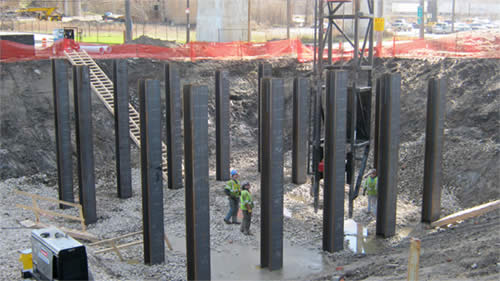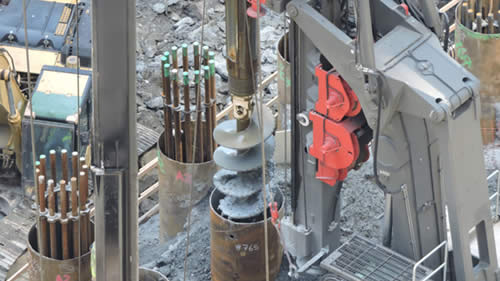Driven Piles

Driven steel piles are the most reliable type of foundation because they are more rigorously tested than almost anything else in the entire construction industry. In addition to structural testing, the capacity of the soil that supports the pile is also tested during the installation process. A combination of the installation method and the test results provides the engineer with powerful information on the capacity of all the driven piles on a site.
When a driven pile is installed, it is subjected to loads which are higher than it will probably ever see during service and it carries those loads hundreds of times in quick succession. As a pile begins to reach capacity, the installation rate slows down and blows from the hammer rise to about 120 blows/foot. At this point, the pile is carrying loads very similar to the design loads and is doing so every single time the hammer strikes the pile. The installation rate of the pile and the blow counts are recorded in the driving record. No other foundation element sees service level loads hundreds of times during installation and this, along with testing, allows the engineer to save as much money as possible for the owner.
Most driven pile projects have a small percentage of the piles that are either statically or dynamically tested. Once those piles have been tested, their driving records can be compared to the driving records of all the other piles. If some of the piles look like they were driving too easily, additional length may be spliced onto the piles and driven further into the ground. Testing can also be done before the production piles are driven. Preliminary testing allows the engineer to determine a point when the contractor can stop driving the production piles. This reduces the amount of driving and lowers the overall project costs. No matter what type of driven steel pile is used you can be confident it will take the required loads.
H-piles, pipe piles and sheet piles are capable of taking very high loads. Nothing is more efficient than an HP when rock or a hard bearing layer is within easy driving distance. For a good combination of skin friction and end bearing or when vertical or lateral loads are very high, pipe piles are the best choice. Sheet piles are especially useful in the right situation because they can be used as both a retaining wall and bearing pile simultaneously.
Drilled Piles

Drilled piles for bridge construction are mostly drilled shafts and micropiles. Although in many ways they are the same, drilled shafts are generally larger than 18”, use a cage for reinforcement and the hole is kept open with a slurry or casing. Micropiles are less than 14” in diameter, use a single bar, permanent casing and use grout installed under pressure. The other important differences are that micropiles are almost always drilled into a bearing layer and the casing is threaded and installed in short lengths, while casing for drilled shafts are usually installed as single pieces and do not necessarily go to a hard layer. Nucor Skyline supplies small diameter threaded casing for micropiles, large casing for drilled shafts and threaded bars for reinforcement. The drilled hole for the shaft is kept open with slurry, temporary casing or permanent casing.
There are several good reasons to use permanent casing for drilled shafts. One of the most important reasons to use casing to keep the hole open is so the bottom can be inspected and thoroughly cleaned. If slurry is used, it is much more difficult to prevent soft bottom problems. Casing also prevents the soil from pushing into the shaft. This can weaken the concrete mix or cause voids to develop in the shaft. In addition to the loss of compressive strength, the concrete voids can also lead to problems with exposed parts of the cage. The casing allows for much more reliable placement of the cage and flow of the concrete.
Steel pipe has a lot of bending strength and vertical load carrying capacity. There is no reason not to take advantage of the strength of all of the casing and reduce the size of the cage. As the drilled shaft sheds load through skin friction, the size of the cage can be reduced. Nucor Skyline threaded bar cages make it easy to vary the number, position and sizes of bars at varying elevations.
An often overlooked benefit of the casing is that it performs one of the two functions of the spiral reinforcement. For traditional cages, the spiral prevents the concrete from blowing out the side of the shaft. Pipe works very well at containing the concrete and even very thin walled casing can take the place of a robust spiral.
The other function of the spiral is to keep the vertical bars in position during construction. Nucor Skyline threaded bar cages use ring plates spaced, 10-15 feet apart, to keep the bars aligned. Eliminating the spiral reduces the cost of the cage itself and also allows for additional room for concrete to flow within the cage. This extra space also allows for concrete mix designs with lower slump values and higher strengths, which can reduce the overall size and cost of the drilled shaft.
The high strength threaded bar cages offered by Nucor Skyline are very versatile due to the variety of bar sizes and grades and the threaded connections. The ring plates and fully threaded connections allow the designer to optimize the cage design by placing different sizes and numbers of bars at different elevations. The couplers are capable of taking the full tensile capacity of the bar so it is not necessary to overlap bars. Very long cages can be made in the shop, disassembled into partial lengths (60’ or less) and then reassembled on site with tap through couplers. This makes construction of deep shafts very quick, easy and reliable.